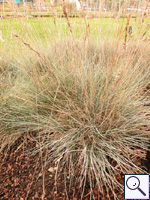|
||||||
|
FESTUCA. Fescues. [Poaceae] |
|
|
Twenty-one species of Festuca are recorded in Britain. Fourteen of these are native and include Tall Fescue (F. arundinacea). Festuca arundinacea is treated as Schedonorus arundinacea, Festuca gigantea is treated as Schedonorus gigantea, and Festuca pratensis is treated as Schedonorus pratensis by Stace (2010). Thirty-three British miners are recorded on Festuca. A key to the European miners recorded on Festuca is provided in Bladmineerders van Europa. Nearly 100 British miners or possible miners are recorded on grasses in Britain. It is recommended that adults of all miners on grasses be reared to be certain of their identity. |
|
Key for the identification of the known mines of British |
|
Note: Diptera larvae may live in a corridor mine, a corridor-blotch mine, or a blotch mine, but never in a case, a rolled or folded leaf, a tentiform mine or sandwiched between two more or less circular leaf sections in later instars. Pupation never in a cocoon. All mining Diptera larvae are leg-less maggots without a head capsule (see examples). They never have thoracic or abdominal legs. They do not have chewing mouthparts, although they do have a characteristic cephalo-pharyngeal skeleton (see examples), usually visible internally through the body wall. The larvae lie on their sides within the mine and use their pick-like mouthparts to feed on plant tissue. In some corridor miners frass may lie in two rows on alternate sides of the mine. In order to vacate the mine the fully grown larva cuts an exit slit, which is usually semi-circular (see Liriomyza huidobrensis video). The pupa is formed within the hardened last larval skin or puparium and as a result sheaths enclosing head appendages, wings and legs are not visible externally (see examples). See Key to non-Diptera. |
|
1a > Leaf-miner: Larval leaf-mine starts as a narrow channel running towards apex of leaf but later develops into a broad blotch running downwards. Frass largely diffused, giving the mine a characteristic greenish appearance. Pupation external (Spencer, 1976: 126). Corridor, usually several in one leaf, running from close to the leaf base up to near the tip, then reversing direction and widening, resulting in one communal mine in which the larvae descend in a common front. Frass somewhat deliquescent, mine therefore strikingly green. Pupation outside the mine. Neither mine nor larva distinguishable from those of mobilis. Puparium reddish brown |
|
|
|
Agromyza nigrella (Rondani, 1875) [Diptera: Agromyzidae]. |
|
1b > Leaf-miner: Larvae feed singly, forming an upper surface linear-blotch mine. Pupation either internal or external, with the puparium loosely glued to the leaf (Spencer, 1976: 91). Oviposition near the leaf margin, at some distance from the leaf tip. From there develops an upper-surface corridor-blotch. At first the mine ascends as a narrow corridor towards the leaf tip, then the direction turns and the mine, steadily widening, descends in the direction of the leaf base. Frass irregular, in rather coarse grains. Larva solitary. Pupation mostly outside the mine; in that case the puparium often sticks to the leaf. |
|
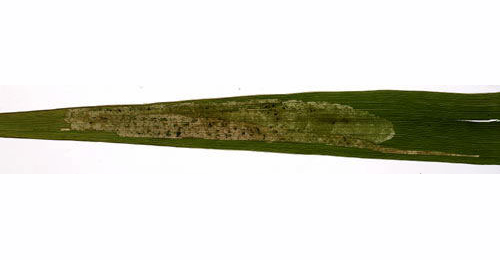 Mine of Agromyza albipennis on Phalaris arundinacea Image: © Willem Ellis (Bladmineerders van Europa) |
|
|
|
Agromyza albipennis Meigen, 1830 [Diptera: Agromyzidae]. |
|
1c > Leaf-miner: Long upper-surface corridor usually containing several larvae that graze shoulder to shoulder from the leaf tip downwards. Pupation outside the mine. Mines and larvae are indistinguishable from those of A. nigrella. |
|
|
|
Agromyza mobilis Meigen, 1830 [Diptera: Agromyzidae]. |
|
1d > Leaf-miner: Larva feeds mainly in the leaf sheaths. The short mines which may be formed in the leaf blade may be easily overlooked. Pupation internal (Spencer, 1976: 178). Mine begins as a narrow, usually upper-surface, occasionally lower-surface or interparenchymatous corridor in the blade, that descends towards the ligule, thence continues into the leaf sheath, generally on its inside. Usually only one mine per leaf. Puparium in a puparial chamber at the margin of the leaf sheath. Neither mine nor larva can be distinguished from that of C. fulvipes that, as far as is known, only feeds on Poa trivialis. |
|
|
|
Cerodontha denticornis (Panzer, 1806) [Diptera: Agromyzidae]. |
|
1e > Leaf-miner: A lower surface mine. Pupation normally in the ground (Spencer, 1976: 202). Broad, usually lower-surface corridor in the blade, generally first rising, then descending. Mostly one larva in a mine, but sometimes several mines on a leaf may merge. Frass in grains that gradually become both larger and more widely spaced. Pupation outside the mine. |
|
|
|
Cerodontha flavocingulata (Strobl, 1909) [Diptera: Agromyzidae]. |
|
1f > Leaf-miner: Broad elongated mine; the form is dependent of the leaf form of the host plant. Frass green. Usually a number of larvae together in a mine. Pupation in the mine. |
|
|
|
Cerodontha incisa (Meigen, 1830) [Diptera: Agromyzidae]. |
|
1g > Leaf-miner: Larva solitary. Broad lower surface mine which generally starts at the leaf apex.The mine is somewhat irregular in depth. Frass in irregular black-green, frequently melted grains, most along the edges of the mine. Pupation generally internal. Puparium shining metallic bluish-black, posterior spiracles projecting through the epidermis. |
|
|
|
Cerodontha muscina (Meigen, 1830) [Diptera: Agromyzidae]. |
|
1h > Leaf-miner: Long, lower- or upper-surface blotch in the apical part of the leaf, occupying the entire width of the blade. Frass in a few lumps. Pupation internal. |
|
|
|
Cerodontha rohdendorfi Nowakowski, 1967 [Diptera: Agromyzidae]. |
|
1i > Leaf-miner: Normally several larvae feed together. Pupation in the mine. Puparium shining black (Spencer, 1976: 198). Broad elongated blotch. Frass greenish. Larvae generally communal. Pupation within the mine. The black puaria are individially anchored within the mine with a silken thread attached at their rear end. Distinguishable from C. incisa only by means of the larva. |
|
|
|
Cerodontha pygmaea (Meigen, 1830) [Diptera: Agromyzidae]. |
|
1j > Leaf-miner: Long, narrow, whitish mine. Pupation internal (Spencer, 1976: 453); anterior spiracles projecting through the epidermis. Whitish, upper-surface, rather narrow corridor with comparatively large frass grains that are laying further apart than their diameter. Pupation within the mine. The anterior spiracles of the orange-brown puparium penetrate the epidermis. |
|
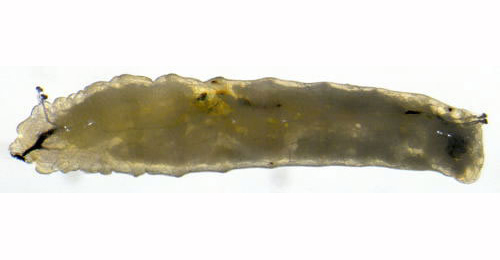 Chromatomyia nigra larva, lateral Image: © Willem Ellis (Bladmineerders van Europa) |
|
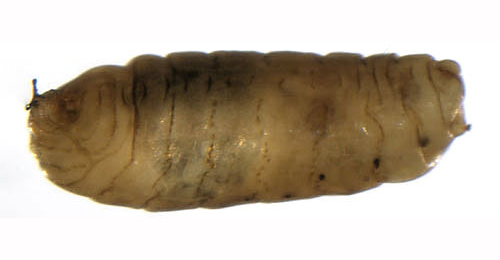 Chromatomyia nigra pupa, lateral Image: © Willem Ellis (Bladmineerders van Europa) |
|
|
|
Chromatomyia nigra (Meigen, 1830) [Diptera: Agromyzidae]. |
|
1k > Leaf-miner: Narrow whitish mine, with frass in distinct black lumps. Pupation internal (Spencer, 1976: 422). Whitish, upper-surface, descending corridor, about halfway up the blade. Frass in distinct black grains that are lying further apart than their diameter. Pupation in the mine. |
|
|
|
Chromatomyia fuscula (Zetterstedt, 1838) [Diptera: Agromyzidae]. |
|
1l > Leaf miner: A substantial linear mine. Pupation internal; posterior spiracles projecting through the epidermis (Spencer, 1976: 449). Elongated, shallow, upper-surface or lower-surface blotch, not infrequently several in one leaf. Frass in strings or pearl chains. Pupation within the mine. |
|
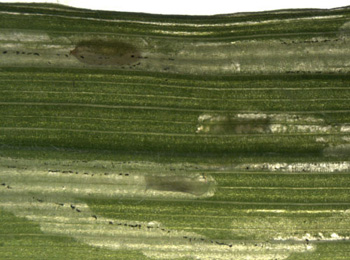 Mine of Chromatomyia milii on Holcus lanatus Image: © Willem Ellis (Bladmineerders van Europa) |
|
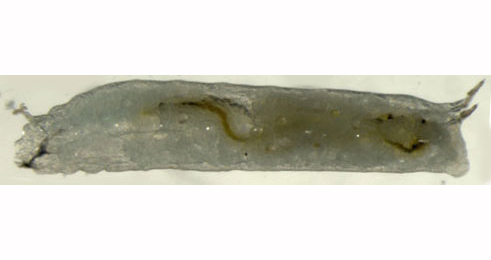 Chromatomyia milii larva, lateral Image: © Willem Ellis (Bladmineerders van Europa) |
|
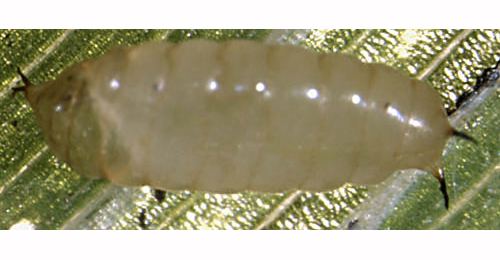 Chromatomyia milii larva, dorsal Image: © Willem Ellis (Bladmineerders van Europa) |
|
|
|
Chromatomyia milii (Kaltenbach, 1864) [Diptera: Agromyzidae]. |
|
1m > Leaf-miner: Upper surface corridor mine. The mine starts at the leaf apex. Frass in clumps or closely packed grains. |
|
|
|
? Liriomyza graminivora Hering, 1949 [Diptera: Agromyzidae]. |
|
1n > Leaf-miner: A short narrow mine, generally near apex of leaf. Larva with each segment bearing a row of characteristic papilli which are retained in the puparium (Spencer, 1976: 328). Pupation internal. Transparent, short and narrow mine not far from the leaf tip. Frass in two rows of grains. Pupation outside the mine. |
|
|
|
Pseudonapomyza atra (Meigen, 1830) [Diptera: Agromyzidae]. |
|
1o > Leaf-miner: Irregular mine, locally shallow, elsewhere much deeper, giving it a mottled appearance. In broadleaved plants the mine often begins as a blotch with stellate extensions, but sometimes as a very fine, shallow corridor. In grasses the mine often begins in the leaf sheath. The frass is very fine-grained, initially scattered, later in aggregates. |
|
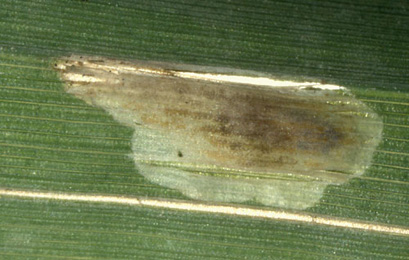 Mine of Hydrellia griseola on Glyceria fluitans Image: © Willem Ellis (Bladmineerders van Europa) |
|
|
|
Hydrellia griseola (Fallén, 1813) [Diptera: Ephydridae]. |
|
|
Key for the identification of the known mines of British |
Note: The larvae of mining Coleoptera, Hymenoptera and Lepidoptera may live in a corridor mine, a corridor-blotch mine, a blotch mine, a case, a rolled or folded leaf, a tentiform mine or sandwiched between two more or less circular leaf sections in later instars. Larva may pupate in a silk cocoon. The larva may have six legs (although they may be reduced or absent), a head capsule and chewing mouthparts with opposable mandibles (see video of a gracillarid larva feeding). Larvae of Hymenoptera and Lepidoptera usually also have abdominal legs (see examples). Frass, if present, never in two rows. Unless feeding externally from within a case the larva usually vacates the mine by chewing an exit hole. Pupa with visible head appendages, wings and legs which lie in sheaths (see examples). |
1# > Leaf-miner: Narrow, flat gallery, descending from the tip of the leaf. |
|
Elachista collitella (Duponchel, 1843) [Lepidoptera: Elachistidae]. |
1# > Leaf-miner: Full depth gallery; de first mine is descending, but later mines generally are ascending (Robbins, 1991a).. |
|
Elachista triatomea (Haworth, 1828) [Lepidoptera: Elachistidae]. |
1a > Leaf-miner: Makes long narrow galleries. The frass is distributed through the mine and also some is ejected. The larvae may mine more than one leaf. Elongate, rather irregular blotch. Most frass is ejected, what remains is concentrated in a few heaps. The larva makes several mines. Pupaton outside the mine. |
|
Cosmopterix orichalcea Stainton, 1861 [Lepidoptera: Cosmopterigidae]. |
1b > Leaf-miner: Tufted hair-grass and blue moor-grass are the main foodplants, the larvae forming gallery mines. Gradually widening corridor, running either upwards or down. All frass is deposited in the earliest part of the mine. Often 2-3 larvae in a mine; in grasses with broad leaves sometimes more than one mine in a leaf. |
| On Deschampsia and Sesleria, but not yet on Festuca, in Britain and Carex, Brachypodium, Calamagrostis, Deschampsia, Elymus, Festuca, Melica, Milium, Phleum, Poa and Sesleria elsewhere. Occurs in woodland habitats in England, Wales and locally in Ireland. Also recorded in the Channel Is. and the Republic of Ireland. Widespread in continental Europe. |
Elachista adscitella Stainton, 1851 [Lepidoptera: Elachistidae]. |
1c > Leaf-miner: The larva mines from the grass tip downwards and the mine occupies half or the whole of the leaf blade width. A whitish blotch is formed with characteristic narrow streaks of frass. Full depth blotch, slightly inflated, descending from the leaf tip, occupying half or the entire width of the blade. The larva may move and make a new mine elsewhere. In the latter case the mines are fairly short; otherwise an entire blade may be mined out. Frass in a some narrow greyish brown streaks. Pupation outside the mine. |
|
Elachista albifrontella (Hübner, 1817) [Lepidoptera: Elachistidae]. |
1d > Leaf-miner: Corridor widening while descending from the tip of the leaf. The mine is unusual because the sides are very irregularly scalloped out. Moreover, the mine is not evenly transparent, but rather yellowish green and motly, because the larva leaves patches of parenchyma uneaten, and does not feed full depth. Frass in a few irregular, interrupted length lines. Often 2-3 larvae in a mine. The larvae hibernate in the centre of the mine; after winter they leave their mine and pupate. |
|
Elachista apicipunctella Stainton, 1849 [Lepidoptera: Elachistidae]. |
1e > Leaf-miner: In autumn the larva makes a narrow corridor a few cm in length, in which it hibernates. In March it moves to a new leaf. Here a transparent, full depth mine is made that descends from the leaf tip, and occupies the entire width of the blade. Most frass is concentrated in the oldest, highest, part of the mine. The larva may leave its mine and restart elsewhere. Pupation outside the mine |
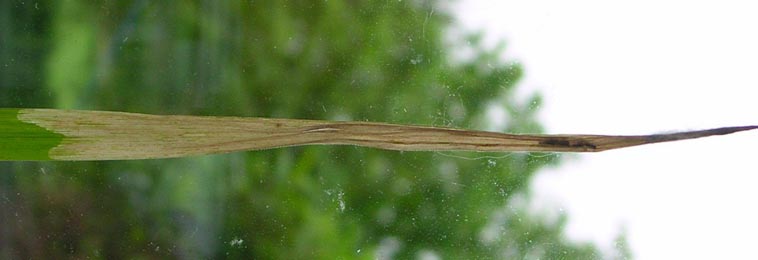 Mine of Elachista argentella on Dactylis glomerata Image: © Ben Smart (British leafminers) |
|
Elachista argentella (Clerck, 1759) [Lepidoptera: Elachistidae]. |
1f > Leaf-miner: Blotch in the leaf tip; the upper side is practically flat, the lower side can turn somewhat to purple. The larva may mine 2-3 leaves. |
|
Elachista bedellella (Sircom, 1848) [Lepidoptera: Elachistidae]. |
1g > Leaf-miner: Mine a descending and widening corridor, in the end an elongate blotch that may occupy the entire width of the leaf. The mine contracts somewhat, narrowing the leaf. Frass in some elongate lumps in the centre of the mine. |
|
Elachista bisulcella (Duponchel, 1843) [Lepidoptera: Elachistidae]. |
1h > Leaf-miner: Flat, whitish. Pupation outside the mine. |
|
Elachista canapennella (Hübner, 1813) [Lepidoptera: Elachistidae]. |
1i > Leaf-miner: Long, flat, whitish, relatively broad corridor descending from the leaf tip. Frass irregularly scattered. The larva may make several mines during its lifetime. Pupation outside the mine. |
|
Elachista freyerella (Hübner, 1825) [Lepidoptera: Elachistidae]. |
1j > Leaf-miner: In spring a short corridor is made that is almost stuffed with frass. After hibernation this mine is vacated, and the larva then makes a number of elongated blotches, all descending from the leaf tip. These latter mines are whitish, with irregularly scattered frass. |
|
Elachista humilis Zeller, 1850 [Lepidoptera: Elachistidae]. |
1k > Leaf-miner: Long, narrow, white corridor, descending from close to the leaf tip to the leaf base or even stem. Frass in an inconspicuous grey line. From the stem the larva may enter a new leaf (Steuer, 1987a; Bland, 1996a). |
|
Elachista luticomella Zeller, 1839 [Lepidoptera: Elachistidae]. |
1l > Leaf-miner: Larva makes a large whitish blotch and mines the leaf downwards. The frass tends to be deposited in the upper part of the mine. Oviposition usually not far from the leaf tip. From there descends an irregular blotch mine. Hering (1957a) describes the mine as flat and quite shallow, giving it a greenish, rather than whitish appearance. Frass initially in the oldest, upper part of the mine, later in strings. The larva can leave its mine and restart elsewhere. Normally only one larva per mine, but sometimes two or even three mines in a leaf. Pupation outside the mine. |
|
Elachista maculicerusella (Bruand, 1859) [Lepidoptera: Elachistidae]. |
1m > Leaf-miner: Initially a narrow brownish mine with blackish frass at its base, then moves to another leaf, forming a broader mine. Both mines can pucker the blade. |
|
Elachista obliquella Stainton, 1858 [Lepidoptera: Elachistidae]. |
1n > Leaf-miner: The larvae feed on a range of grasses, causing whitish mines on the blades. Flat, translucent mine that can either run or down; the width may vary too, can be as wide as the blade. Frass few, grey, dispersed. The larva makes several mines. |
|
Elachista rufocinerea (Haworth, 1828) [Lepidoptera: Elachistidae]. |
1o > Leaf-miner: Mines downwards from leaf tip to stem. Makes a long narrow yellowish mine. May be up to four larvae in one leaf. Long narrow yellowish corridor, descending from the leaf tip to its base; at times 3-4 larvae in a leaf. Often several larvae in a communal mine. Pupation outside the mine. |
|
Elachista stabilella Stainton, 1858 [Lepidoptera: Elachistidae]. |
1p > Leaf-miner: Narrow, flat, corridor descending from the leaf tip. Frass in an almost continuous line. The larva usually makes several mines. Mines pale yellow green at first, turning purple later. Pupation external. |
|
|
Elachista subnigrella Douglas, 1853 [Lepidoptera: Elachistidae]. |
1q > Leaf-miner: The mine begins somewhere halfway the blade as an upwards running corridor. After a while the direction reverses, and an elongate blotch develops occupying half the width of the leaf. Frass, light green at first, grey later, concentrated in the lowest part of the mine. Pupation external. |
|
Elachista utonella Frey, 1856 [Lepidoptera: Elachistidae]. |
| Last updated 05-Jul-2019 Brian Pitkin | ||

